2015: SAUCES, GRAVIES AND CONDIMENTS IN REGIONAL ITALIAN CUISINE
 This is the tenth in the series of the Cultural Gastronomic Itineraries and is dedicated to the sauces, gravies and condiments of our cuisine. Once again this year’s edition has been enriched by the contributions of the Academy’s Delegations around the world.
This is the tenth in the series of the Cultural Gastronomic Itineraries and is dedicated to the sauces, gravies and condiments of our cuisine. Once again this year’s edition has been enriched by the contributions of the Academy’s Delegations around the world.
This year’s theme is aimed at rediscovering traditions involving condiments in modern Italian cuisine as well as providing a critical analysis of their use.
2014: THE CUISINE OF RICE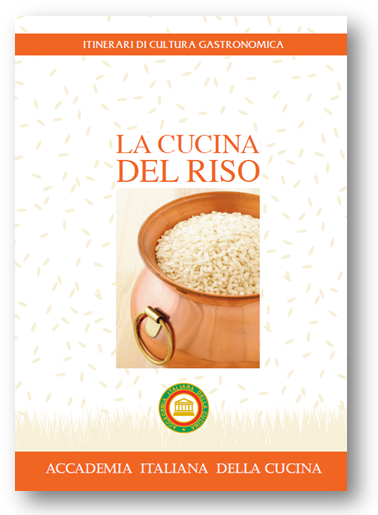
The 2014 edition includes research worthy of an Italian culinary identity, and the traditions and myths that comprise it. The work fills the void, at least in part, of a gap in the historical, critical and sociological scheme regarding the use of rice in the cuisine of various Italian regions.This edition was also enhanced by the contributions of some of the Academy’s Delegations around the world: just one more testimony as to how rice and the various ways of cooking it have combined to change the eating habits of many countries.
![]()
2013: THE CUISINE OF UNFORGETTABLE MEATS
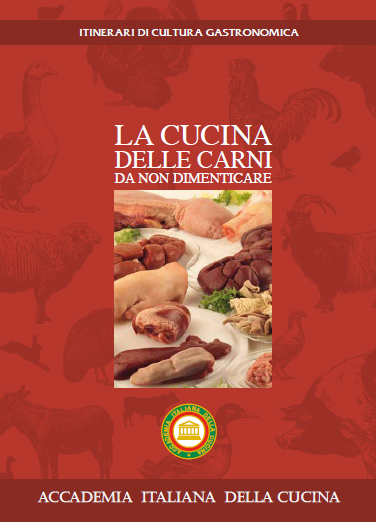
In nutritional mathematics accounts may differ from the canonic ones and unity may comprise not the usual four-fourths but five-fourths. The parts that make up the “fifth quarter” of a butchered animal (internal organs or offal, head, tail, hooves) are not just lowly byproducts of butchering but morsels fit for a king, as tradition can demonstrate. The present day scientific research prizes the fifth quarter since some of its parts allow for the preparation of typical traditional dishes that are popular with gourmets. Unfortunately, owing to a series of erroneous considerations and new prejudices, many innards are not welcome and many tasty traditional recipes, both regional and family based, are being lost. The purpose of this publication is to promote organ meats and offal for their real value, that of good food that is healthy, tasty, clean, low cost and valid from a nutritional standpoint. It is a foodstuff that should be re-evaluated.
2012: THE CUISINE OF HERBS AND SPICES

Scents and tastes were an important part of the family image as well as belonging to a society that was fundamentally local, and is now running the risk of growing dim and even disappearing. Now more than ever, the cultural role of herbs and aromatic plants that identify our traditions becomes important. Herbs – particularly the spontaneous varieties – and the vegetal aromas and their culinary and gastronomic uses are one of the most diffused and important bases of the identity of true Italian regional cuisine.
2011: THE CUISINE OF FRUIT
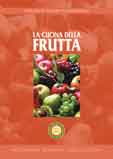
In the present framework of cuisine, fruit seems relegated to a secondary role, perhaps owing to the fact that it tends to be served at the end of a meal, very often in competition with other foods (cheese or dessert), or eaten outside a meal. One thing is certain, however, that man needs not only fruit but also a great variety of it (“alimentary biodiversity”). The present day species of fruit are quite limited and only a few varieties are cultivated industrially. The many different types of fruit that found their place in traditional culinary and gastronomic preparations have been in large part forgotten. For this reason, the Study Center decided to focus its attention on fruit with a special eye to the type of preparations that feature this food as a quality element.
2010: THE CUISINE OF RELIGIOUS FESTIVITIES
 Since olden times a close connection prevailed between religious and alimentary traditions. Food was justified by a cuisine that reflected the territory and the seasonal cycles, while festivities also constituted small pecadillos where the opulence of the day balanced the hunger and abstinence over long periods. Today’s religious festivities, largely impacted by the laity, have lost that character and this loss leads to nutritional insecurity. The recovery of some alimentary traditions of religious festivities rooted in the many cuisines of the Italian territory is by and large an undertaking of a high cultural level that integrates the ever growing movement based upon the study of traditions that enrich Italy, no matter how our populations may be forgetting them.
Since olden times a close connection prevailed between religious and alimentary traditions. Food was justified by a cuisine that reflected the territory and the seasonal cycles, while festivities also constituted small pecadillos where the opulence of the day balanced the hunger and abstinence over long periods. Today’s religious festivities, largely impacted by the laity, have lost that character and this loss leads to nutritional insecurity. The recovery of some alimentary traditions of religious festivities rooted in the many cuisines of the Italian territory is by and large an undertaking of a high cultural level that integrates the ever growing movement based upon the study of traditions that enrich Italy, no matter how our populations may be forgetting them.
2009: THE CUISINE OF THE FARMYARD
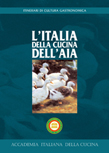 The animals of the farmyard were a precious source of meat and most of all the foundation of a cuisine and gastronomy that has been fading away and in some cases has been lost due to the disappearance of local species and traditional husbandry methods. Yet it is a patrimony that must be protected and better known with the intent of contributing to the emergence of an Italian cuisine capable of maintaining high cultural values based on traditional ones.
The animals of the farmyard were a precious source of meat and most of all the foundation of a cuisine and gastronomy that has been fading away and in some cases has been lost due to the disappearance of local species and traditional husbandry methods. Yet it is a patrimony that must be protected and better known with the intent of contributing to the emergence of an Italian cuisine capable of maintaining high cultural values based on traditional ones.
2008: THE CUISINE OF PORK
 The volume Italy: the Cuisine of Pork, featured as the Yearly Theme of 2008, highlights the territorial peculiarities, region by region, of this highly traditional cuisine, with a wealth of information, investigations and recipes.
The volume Italy: the Cuisine of Pork, featured as the Yearly Theme of 2008, highlights the territorial peculiarities, region by region, of this highly traditional cuisine, with a wealth of information, investigations and recipes.
2007: ITALY AND THE VEGETABLE GARDEN
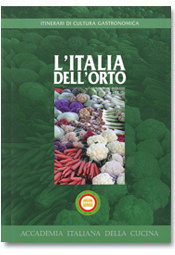 No less important is the theme of the second book: the vegetable garden that encompasses the great gastronomic diversity of Italian regional cuisines. In the past, the cuisine of each single family had its own peculiar features in that it brought to the table the taste of its own vegetable garden. Today, quite often dishes based upon revised recipes utilize vegetables that are far from being typical. This volume illustrates the typical character of produce and recipes in an attempt to spread this knowledge and to recover and save an important part of the traditional Italian cuisine.
No less important is the theme of the second book: the vegetable garden that encompasses the great gastronomic diversity of Italian regional cuisines. In the past, the cuisine of each single family had its own peculiar features in that it brought to the table the taste of its own vegetable garden. Today, quite often dishes based upon revised recipes utilize vegetables that are far from being typical. This volume illustrates the typical character of produce and recipes in an attempt to spread this knowledge and to recover and save an important part of the traditional Italian cuisine.
2006: THE CUISINE OF FISH
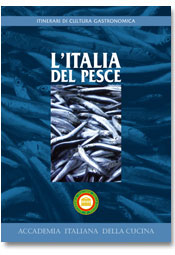
Italy boasts thousands of miles of coastline and its regions have a wealth of lakes, rivers and streams. Besides the abundant ways in which regional cuisine employs the fish products of the territory through local recipes, fish, chosen as the theme of the first volume of the Itineraries, is a unique component of the mosaic of the Italian table.
All texts are available exclusively in the Italian language.
